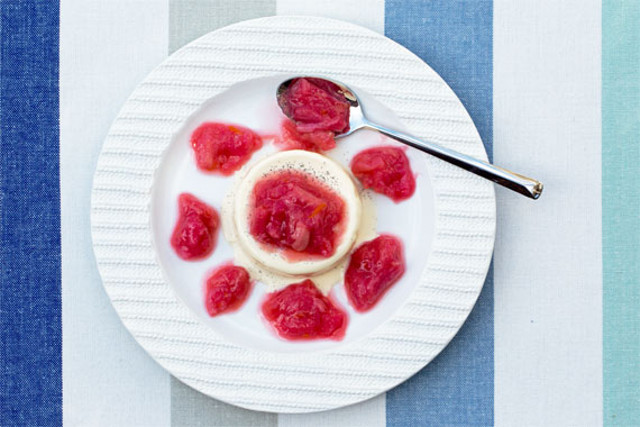Summary
Serves: 4
Preparation: 5 minutes
Cooking: 40 minutes
Ingredients
Rhubarb compote:
350 g (12 oz) rhubarb
75 g (5tbsp) caster (superfine) sugar)
1 small orange, zest and juice
2 tbsp water
Panna cottas
300 ml (1¼ cups) double (heavy) cream
120 ml (½ cup) whole milk (3-5% fat)
60g (¼ cup) caster (superfine) sugar
1 vanilla pod, split lengthways
2 sheets gelatine
Method
1. Preheat the oven to 140ºC (290ºF, gas 1, fan 140ºC) and lightly oil four ramekins.
2. Rinse the rhubarb and cut into 3 cm (1”) pieces. Add to a bowl with sugar, orange zest, 2 tablespoons of orange juice and 2 tablespoons of water. Mix thoroughly and tip into a roasting pan, spreading out the rhubarb so that it cooks in a single layer. Roast for 30 minutes.
3. Meanwhile, add the cream, milk, sugar and vanilla pod to a saucepan. Slowly heat the mixture to simmering point, stirring as you do so, then remove from the heat and leave to infuse whilst you prepare the gelatine.
4. Add the leaf gelatine to a bowl of cold water and leave to soak for 5 minutes. Squeeze the excess water out of the gelatine and add to the vanilla cream. Mix until the leaves have melted and then strain the mixture through a sieve into 4 ramekins. When cold, transfer the ramekins to a fridge for at least 3 hours to set.
5. When the rhubarb is cooked, strain the juices into a small pan and transfer the rest to a bowl. Gently cook the juices until they are nicely coloured and have thickened. Pour over the rhubarb, stir and leave to cool until required (this helps to improve the colour of the cooked rhubarb).
6. To serve, dunk the bases of the ramekins in hot water for 30 seconds to loosen them, run a knife round the edge of the ramekins and then tip out onto serving plates. Spoon the rhubarb compote over and around the panna cottas.
Tips
– For the best colour and flavour, use forced rhubarb. Forced stems have less of the bitterness of uncovered rhubarb so need less sugar to balance their tartness, while the taste is more delicate. Combined with their tender texture, it makes forced rhubarb a king among early crops.
– Instead of turning the panna cottas out on to plates, make them in dishes or glasses, pile the rhubarb on top and garnish with mint leaves.
– If possible, use quick dissolving gelatine sheets as they are so easy to use. If you can't get the same size packets you will need to do a conversion! This recipe uses two sheets from a 25 g packet containing 15 sheets (each sheet will lightly set approximately 200 ml (¾+ cup) of liquid).
– For ginger lovers, crumble over some stem ginger shortbread.
Recipe courtesy of John Duxbury, founder and editor of Swedish Food.



 Please whitelist us to continue reading.
Please whitelist us to continue reading.